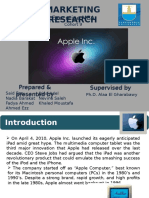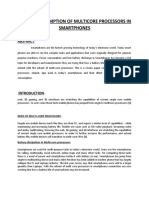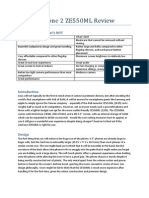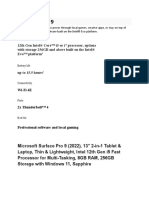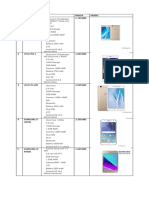Making Sense of Smartphone Processors:
The Mobile CPU/GPU Guide
Smartphone manufacturers these days boast of their phones computer-like capabilities, from
desktop-like internet browsing to HD video playback. They toss around spec sheets filled
with processor names like ARM11, Cortex A8, Snapdragon, Tegra, OMAP, Armada, and
more. What do these all mean, and how do the various chips compare? Thats what were
going to take a look at today.
Introduction
Over the last few months, the smartphone industry has seen an unpredecented focus on
processing hardware. For example, Apples June 8, 2009 launch of the iPhone 3GS focused
primarily on new hardware features, and that too, mostly on its processors, rather than major
sensor upgrades (a 3.2 MP AF camera and digital compass aside). The 3GS was touted as
consistently offering more than twice the performance of the first- and second-generation
iPhones, yet offering the same or better battery life.
�Much of the buzz around HTC's HD2 was due to its 1 GHz Qualcomm Snapdragon processor
Similarly, Toshibas TG01, HTCs HD2, and HTCs Google Nexus One were launched with
much fanfare, with their key feature being a 1 GHz Qualcomm Snapdragon processor that was
also claimed to provide a major performance boost. Separately, Windows Mobile giant HTC
found itself in the midst of a great controversy over missing drivers for hardware graphics
acceleration, along with slow general performance, in the platform it uses in much its lineup
today, the Qualcomm MSM72xx series.
Much speculation and excitement surrounds new smartphones featuring processors like
Qualcomms Snapdragon, Nvidia Tegra/Tegra 2, TI OMAP 3/4, and various other
implementations of ARM Cortex A8/A9. Most people who have heard of these mobile
platforms or have seen various demo videos simply know that they are faster than whats
found in smartphones today. But what exactly is Tegra, and how does it compare to
Snapdragon or to todays mobile processors?
Well first go through each of the major processor families around in phones today, and then
well analyze them. To keep it readable, we well go over differences in the processor
architectures without drowning in excessive technical detail.
Inside the Smartphone
�Overview of a typical desktop computer
Our story starts with the desktop PC, because smartphones are essentially pocket-sized
computers that have a few extra radios and operate in extremely confined conditions vis-a-vis
power consumption, heat output, etc. A PC consists primarily of a motherboard chipset
(typically split into a Northbridge that connects to the processor and memory (Intels P45,
for example), and a Southbridge that connects to various peripheral buses, like PCIExpress, USB, etc. (Intels ICH10R, for example)), a central processing unit (CPU Intels
Core 2 Duo, for example), application memory (RAM), permanent storage (hard drive or
solid-state disk), a graphics processing unit (GPU ATIs Radeon HD5890, for example), a
power supply, and several peripherals connected to the PCI or PCI-Express buses (a built-in
sound chipset or an add-on Wi-Fi card, for example).
Inside the Apple iPhone 3GS - the Samsung applications processor (in black) encompasses the
CPU, GPU, sound chipset, and more; the baseband processor (also in black) handles cellular
communication.
Smartphones also have all of these components, except with much more integration a few
main chips can often encompass the CPU, GPU, other specialized coprocessors, motherboard
buses, memory controller, LCD controller, sound chipset, CMOS camera interface, on-board
memory, and several peripheral devices (such as Cell, Wifi, and Bluetooth radios). The
applications processor is the chip responsible for general processing (something like a CPU
�+ motherboard chipset) and may have several other functions built into it. The baseband
processor is responsible for cellular wireless communications.
Wheres my quad-core iPhone with water cooling?
So if smartphones are so similar to PCs, then
why dont we see, say, an x86 CPU like Core 2 Duo in a smartphone today? The answer is
that Core 2 Duo simply consumes far too much power and produces far too much heat than is
acceptable in a phone. A typical desktop Core 2 Duo CPU can consume up to 65W and
requires an active cooling system to keep it from overheating. Even Intels Atom chip
consumes 4W (peak TDP), while entire cellphones must often fit in sub-1W power budgets.
Enter ARM, a mobile processor architecture that dominates high-end mobile phones and
embedded devices like network routers. In its lowest power state, an Atom processor can
consume about 100 mW, compared to 1 mW for some ARM chips. Intel is working on
smaller, cooler-running, and more power-efficient versions of Atom (see Intel codename
Penwell) that may finally bring x86 (and thus compatibility with desktop OSes and
applications) to mobile phones in a few years, but for now, ARM is king on mobile, and all of
the processors well be looking at below are based on ARM instruction sets.
The World of ARM
If all smartphones today use ARM chips, why are some much faster and more expensive than
others? ARM operates quite differently from Intel, it turns out. Whereas Intel designs and
builds all of its own processors, ARM instead creates instruction sets any CPU following
them will be able to run ARM-compatible code. It also creates reference designs for
processors that fit their instruction sets, which allows companies to easily produce their own
chipsets around ARMs core designs.
Some companies, like Nvidia, Samsung, and Texas Instruments simply license and adopt the
ARM CPU reference design, whereas others, like Qualcomm and Marvell, license only the
instruction set and create their own processors to fit them.
ARMs most recent instruction set is version 7, and the first ARMv7 reference design was
Cortex A8, whose architecture is found in todays high-end smartphones. Lower-end
smartphones today tend to use ARM11 chips, which implement the ARMv6 instruction set.
�Nvidia Tegra
Nvidia's Tegra APX2500 Chipset, found in Microsoft's ZuneHD
Smartphone chipsets use different approaches to integration. One of the key selling points of
Nvidias Tegra chipset, for instance, is that its applications processor has several small,
specialized processors built into it, each meant for particular tasks. Many chipsets are made
this way, but Tegra has more dedicated co-processors than most. While Nvidia has used a
somewhat deceptive marketing technique of calling Tegra a 7-core processor (it only has one
general-purpose ARM11 processor), this approach does give two advantages. First, since
dedicated processors are handling a number of tasks, the general-purpose core is freed up to
handle user tasks. More importantly, Nvidia has designed Tegra to aggressively cut power
consumption by turning off parts of the processor that arent being used. For instance, if a
Zune HD is playing music with its screen off, why power anything but the audio processor
and whatevers needed to get the song file from storage?
�Tegra II solves most of the first-generation chip's issues, such as relatively weak general
processing power (due to the first model's aging ARM11 CPU core)
Performance-wise, the first-generation Tegra is a bit of a mixed bag. As well see below, its
graphics performance is top-notch, exceeding that of any smartphone on the market. Yet its
general performance is held back by the aging, single ARM11 CPU at 600 MHz. While
Tegras specialized hardware and ability to aggressively manage power consumption by
cutting power to coprocessors means that its well-suited to a media player like Microsofts
Zune HD, its not great for smartphones, which tend to need general processing power more
than multimedia capabilities. Nvidia did show faster versions of Tegra, intended for devices
larger than smartphones, but the APX2500 chip in the Zune HD is the only one that actually
ever shipped.
Tegra 2 solves most of the first-gen chips problems. Equipped with a dual-core ARM Cortex
A9 CPU, its at least four times faster than Tegra 1 for general processing. GPU performance
is said to be about twice as fast too, while power consumption remains similar. Nvidia has a
solid all-around platform this time, but questions remain as to whether itll be able to produce
enough chips to feed smartphone makers. Also, Tegra still does not integrate a radio chipset,
which could put it at a competitive disadvantage for smartphones as compared to, say,
Qualcomms Snapdragon chips, which have the radio basebands built-in.
Mobile CPU Overview
Weve compiled an overview of most of the major mobile processor families on the market
today (chips that have not yet shipped in production are italicized):
�ARM vs. Intel
�Laptops began to outsell desktop PCs some time ago, and mobile phones are among the most
ubiquitous devices around. Smartphones are now pushing outwards in two directions: on one
hand, theyre trickling downwards in price, replacing high-end featurephones near the $100
mark, and on the other, theyre pushing upward into the territory of Intel Atom-powered
netbooks or mobile internet devices (MIDs). After all, if people use netbooks primarily for
browsing the internet, checking email, and watching online videos, then what separates
netbooks from high-end smartphones besides screen size?
It should be interesting to watch Intel compete with the whole array of ARM licensees in the
coming years. Over 2 billion ARM chips are shipped every year orders of magnitude greater
than Intels Atom shipments. Intels betting that a shrunken Atom will give it power
consumption comparable to ARMs offerings yet greater processing power and most
significantly, the x86 architecture (meaning compatibility with existing desktop applications
and PC OSes like Windows XP/7).
Halo in Your Pocket? 3D Hits Mobile
Next, well take a look at mobile graphics processing units (GPUs). The role of a GPU is
primarily to provide hardware acceleration for 3D graphics applications like games, CAD,
etc., but in recent years, it has also become responsible for drawing the main user interface in
desktop OSes (more on that later). First up, a comparison of current and upcoming mobile
GPUs, with some non-mobile chips tossed in for reference:
�Why is the GPU relevant if Im not playing games on my phone?
On most modern smartphone platforms (iPhone OS, Android, Palm WebOS, with Windows
Mobile as a notable exception), the OS user interface itself is composited, meaning it is
rendered by the GPU. This makes the interface feel a lot smoother than doing UI display
calculations on the already resource-constrained CPU.
On the desktop, Mac OS X introduced many consumers to a GPU-composited desktop, and
on the PC side, Windows Vista/7s Aero interface provides similar functionality. Windows
XP, even on a very fast desktop rig, generally never feels quite as smooth while, say, moving
around windows, as Windows 7 or Vista running Aero. For the same reason, Windows
Mobile 6.x, which uses a similar rendering mode (GDI) as XP and lacks a GPU-composited
desktop, is going to feel laggy or rough compared to GPU-composited UIs.
More coming soon









































